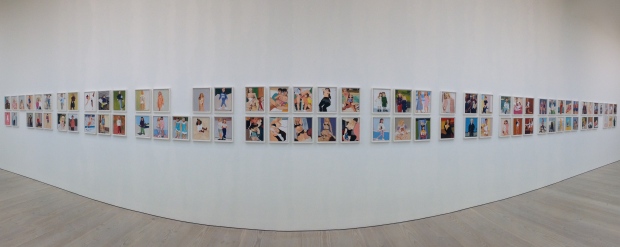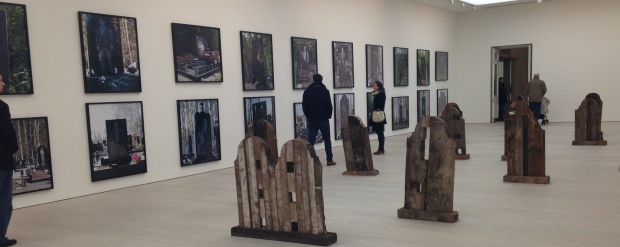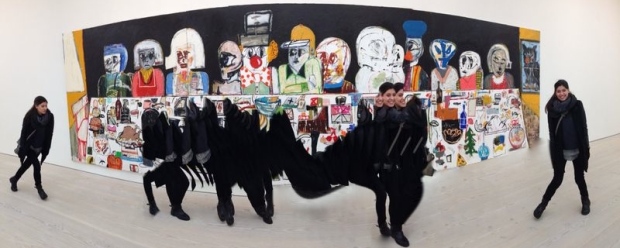What is it about large art pieces, from photographic series to installations and digital projections that excites me so much? I recently revisited Saatchi Gallery in order to take a second look at some larger works that are exhibited there. I took a lot of photographs in order to take a closer look from home; View them as individual works and also as interactive ones with people being captured in the photos, moving inside the exhibition spaced thus becoming a part of the artwork.
Chantal Joffee – Untitled (Oil on Gesso on Board)
Chantal Joffe is a contemporary artist, who could be described to have a humorous eye for everyday awkwardness as she brings a combination of truth and honesty to the genre of figurative art. Her small, humorous drawings usually depicting women or girls have a beautiful sense of complexity that intrigues my curiosity to learn more about the artists intentions, the messages of each smaller painting and its role to the series. ‘The direct and liquid painting style that Chantal Joffe uses has the effect of filling her subjects with personality. The images possess an extra alarming humour that is highly enjoyable and strangely provoking‘ (saatchigallery.com)
The reason why I chose to photographed the piece using a panoramic effect is because I wanted to have a individual photo of the series, but at the same time have central focus. In this way, you can view and understand the many smaller paintings as a series, but you can also have a more detailed understanding of what is illustrated in each one of them by looking closer at the centre.
Denis Tarasov – Essence Series with Marianne Vitale – Installation Markers.
The image above represents two different series by two different artists. The photographys on the wall is by Denis Tarasov and the sculptures in the middle of the space are by Marianne Vitale.
Denis Tarasovs ‘Essence’ showcases the strange phenomenon of modern cultures, one that celebrates material wealth in the face of death. In one of his interviews, he explained that the gravestones he includes in his photographs are not unique occurrences, but they exist in a number of large cities across Russia, Belarus, Ukraine and other former Soviet countries usually concentrated in one area within a cemetery. The artist focuses on the fact that even though all the gravestones are made in the same way and style, they are still different from each other and that is what made him find them all unique and visually interesting. ‘Each has some peculiarity, some distinguishing feature, something that is for me a kind of punctum‘ – Quote by Denis Tarasovs.
Marianne Vitale uses the concept of the process of deterioration and the act of repurposing discarded materials in her work and more specifically in her current sculptures. Made from reclaimed materials, found in old factories and barns, her new series of sculptures ‘Markers’ is composed of weathered wood headstones devoid of inscriptions or epitaphs. The artist uses a number of different techniques when working on her sculptures (burns, bruises, dents, cuts) and references the passage o time by virtue of the natural decomposition of her materials (artsy.net)
Terasov’s photography and Vitale’s sculptures have very different messages and intentions behind them but when exhibited together in a room, they work as a larger and more complex installation which is the reason why I photographed them together and not as individual works. Since they both share the concept of death, they complement each other perfectly creating a mysterious and in my opinion uncomfortable atmosphere that transforms any exhibition space.
Eddie Martinez – The Feast (Mixed Media on Canvas)

Eddie Martinez is a contemporary artist who’s works are well known for being colourful, bold and humorous. His work is a fun, colourful and crudely-rendered assortment of tablescapes with a number of similar abstract figures. Moreover, ‘is at all times evocative of the still lifes and the portraits that dot the landscape of art history, executed in a manner not only revelatory of their influence but aesthetically on par with something else entirely’ (quote from huffingtonpost.com)
The scale of his art works has continuously been growing making the artist to comment in humour: ‘Go big or go home‘. I loved how big, colourful and bold his painting was, so I tried to become a part of it by being in the photograph. Instead of simply posing next to the work, I decided to use a panoramic effect, and so as the camera moved from the right to left, I ran in front of the painting trying to incorporate my movement to the photograph. In that way, I compared my size to the works proportions and included a sense of movement to the still shot.
After looking at these larger pieces in detail, I realised that what in my opinion makes them so exciting is that their large scale gives me the opportunity to view them from different angles and create different narratives. Moreover, I realised that large works and installations intrigue my curiosity and inspire me to experiment with photography; play with angles, lighting, effects (panoramic) and even include people and movement inside the frame, which gives the image different meanings and perspectives. Standing next to large scale works in exhibition spaces made me feel ‘small‘ and was intimidating at first, but after a while it just made me feel inspired.
What do you thing about large art works?
Thanks for reading,
Elli